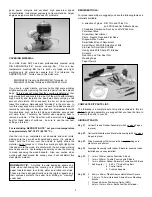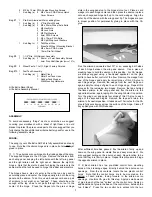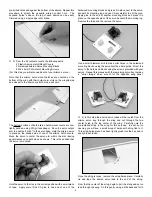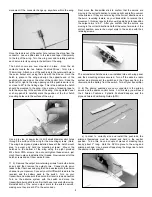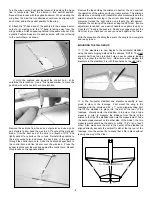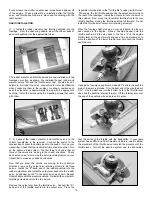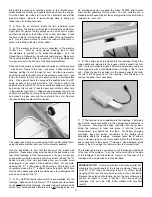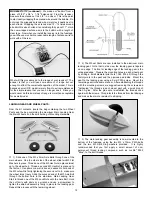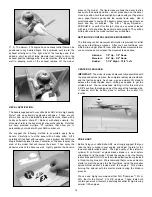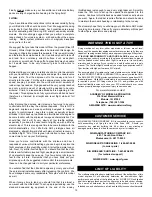
throttled back just enough to see a very slight descent. Smoothly
make the 180
O
turn to set-up the upwind final approach to the
runway. Continue to throttle back as needed to land exactly where
you want. Again, the rudder is quite effective and should be used
to maintain the model's heading in relationship to the runway.
We sincerely hope that you will enjoy your Little Extra ARF model
for a long time to come. Please fly your model safely, with respect
to other flyers, spectators and property.
WARNING! THIS IS NOT A TOY!
Flying machines of any form, either model-size or full-size, are not toys!
Because of the speeds that airplanes must achieve in order to fly, they are
capable of causing serious bodily harm and property damage if they crash.
IT IS YOUR RESPONSIBILITY AND YOURS ALONE to assemble this
model airplane correctly according to the plans and instructions, to ground
test the finished model before each flight to make sure it is completely
airworthy, and to always fly your model in a safe location and in a safe
manner. The first test flights should only be made by an experienced R/C
flyer, familiar with high performance R/C aircraft.
The governing body for radio-control model airplanes in the United States
is the ACADEMY OF MODEL AERONAUTICS, commonly called the AMA.
The AMA SAFETY CODE provides guidelines for the safe operation of R/C
model airplanes. While AMA membership is not necessarily mandatory, it
is required by most R/C flying clubs in the U.S. and provides you with
important liability insurance in case your R/C model should ever cause
serious property damage or personal injury to someone else.
For more information contact:
ACADEMY OF MODEL AERONAUTICS
5161 East Memorial Drive
Muncie, IN 47302
Telephone: (765) 287-1256
AMA WEB SITE: www.modelaircraft.org
CUSTOMER SERVICE
SIG MANUFACTURING COMPANY, INC. is committed to your success in
both assembling and flying the Herr Little Extra ARF.
Should you
encounter any problem building this kit or discover any missing or
damaged parts, please feel free to contact us by mail or telephone.
SIG MANUFACTURING COMPANY, INC.
401-7 South Front Street
Montezuma, IA 50171-0520
SIG MODELER’S ORDERLINE: 1-800-247-5008
(to order parts)
SIG MODELER’S HOTLINE: 1-641-623-0215
(for technical support)
SIG WEB SITE: www.sigmfg.com
LIMIT OF LIABILITY
The craftsmanship, attention to detail and actions of the builder/flyer of this
model airplane kit will ultimately determine the airworthiness, flight
performance, and safety of the finished model. SIG MFG. CO.’s obligation
shall be to replace those parts of the kit proven to be defective or missing.
The user shall determine the suitability of the product for his or her
intended use and shall assume all risk and liability in connection therewith.
15
Finally, always make sure your transmitter and airborne battery
packs are fully charged before heading to the flying field!
FLYING:
If you have followed the instructions in this manual carefully, flying
your Little Extra ARF should be a lot of fun! We suggest choosing
a calm day for test-flying this model. Such conditions are always
best for evaluating and trimming R/C aircraft, especially smaller
models. We also strongly suggest that you perform a complete
range check of your radio system - with and without the engine
running.
Radio system problems will not magically disappear
once you're in the air!
We suggest that you take this model off from the ground (Rise Off
Ground). While it might be possible to hand-launch this design, its
low wing configuration makes this awkward. This is a small model
and therefore has small wheels. So it is obviously best to take off
and land from a relatively smooth surface, such as asphalt,
concrete, or smooth dirt. Taking off of a grass field may be doable
but it would have to be very close-cut grass to allow this to
happen.
Before starting your engine, carefully check all control movements
with you transmitter. Start the engine and adjust the needle valve
for peak rpm's. Taxi the airplane out to the runway and turn it
directly into the wind. Throttle up the engine slowly, while gaining
speed, keeping it pointed into the wind with small amounts of
rudder input as needed. Flying speed will be very quickly reached
and only a small amount of elevator will be needed to become
airborne. Climb to a reasonable altitude before beginning to trim
the model. This airplane has a fully symmetrical airfoil and should
therefore be trimmed for straight and level flight while at full
throttle.
After trimming the airplane, start making a few turns to become
comfortable with the way the airplane responds. This is NOT a
beginner's airplane and was specifically designed to respond
quickly to control inputs - keep this in mind, especially at lower
altitudes! Climb back up to altitude and throttle back the engine to
become familiar with the airplane's low speed characteristics. You
should find that it will fly very slowly at low throttle settings,
especially if you keep the nose level or slightly up with a little up
elevator input. This is also a good time to become familiar with the
stall characteristics.
Our Little Extra ARF prototypes have all
displayed a straight-forward stall with almost instant recovery to
controlled flight. All of this is great information to have when it
comes time to set up your first landing.
Once you're more comfortable with the airplane and how it
responds at various throttle settings, you can begin to explore the
flight envelope of this great little model. Start with a simple loop or
two. Next, try a little inverted flight. You should find that the Little
Extra is comfortable in inverted flight, needing only a small amount
of up elevator to keep the nose up. Try a few aileron rolls to get a
feel for the roll rate. Remember that you have likely set your
airplane up with the suggested initial control throw movements -
these can be changed later to suit your particular preferences.
You will also find that the Little Extra spins very nicely and will exit
the spin almost instantaneously after releasing the controls. We
have managed some very respectable "flat spins" with this model
as well.
When it comes time to land, you should find that it is almost a
non-event with the Little Extra! To set-up a proper landing, use the
standard downwind leg approach to the end of the runway,


